Mars 2020
Mars 2020 is a Mars rover mission that includes the rover Perseverance, the small robotic helicopter Ingenuity, and associated delivery systems, as part of NASA's Mars Exploration Program. Mars 2020 was launched from Earth on an Atlas V launch vehicle at 11:50:01 UTC on 30 July 2020,[4] and confirmation of touch down in the Martian crater Jezero was received at 20:55 UTC on 18 February 2021.[5] On 5 March 2021, NASA named the landing site of the rover Octavia E. Butler Landing.[6] As of 25 October 2023, Perseverance and Ingenuity have been on Mars for 953 sols (979 total days; 2 years, 249 days).[7][8][9][10][11]
 | |
| Mission type | Mars exploration |
|---|---|
| Operator | |
| COSPAR ID | 2020-052A |
| SATCAT no. | 45983 |
| Mission duration | 1 Mars year (668 sols, 687 Earth days) (planned) 3 years, 2 months and 25 days (elapsed) |
| Spacecraft properties | |
| Spacecraft | Perseverance Ingenuity |
| Launch mass | 3,649 kg (8,045 lb) |
| Start of mission | |
| Launch date | 30 July 2020, 11:50:00 UTC |
| Rocket | Atlas V 541 (AV-088) |
| Launch site | Cape Canaveral, SLC-41 |
| Contractor | United Launch Alliance |
| Mars rover | |
| Landing date | 18 February 2021 2 years ago |
| Landing site | Octavia E. Butler Landing, Jezero 18.4447°N 77.4508°E |
| Distance driven | 21.28 km (13.22 mi) as of 19 October 2023 [1] |
| Mars aircraft | |
| Landing date | 3 April 2021 (Deployed from Perseverance)[2] |
| Landing site | Helipad at Wright Brothers Field near Octavia E. Butler Landing, Jezero[3] 18.44486°N 77.45102°E |
| Distance flown | 14.459 km (8.984 mi) in 63 flights[1] as of 19 October 2023 |
  NASA and JPL insignias | |
Perseverance is investigating an astrobiologically relevant ancient environment on Mars for its surface geological processes and history, and assessing its past habitability, the possibility of past life on Mars, and the potential for preservation of biosignatures within accessible geological materials.[12][13] It will cache sample containers along its route for retrieval by a potential future Mars sample-return mission.[13][14][15] The Mars 2020 mission was announced by NASA in December 2012 at the fall meeting of the American Geophysical Union in San Francisco. Perseverance's design is derived from the rover Curiosity, and it uses many components already fabricated and tested in addition to new scientific instruments and a core drill.[16] The rover also employs nineteen cameras and two microphones,[17] allowing for the audio recording of the Martian environment. On 30 April 2021, Perseverance became the first spacecraft to hear and record another spacecraft, the Ingenuity helicopter, on another planet.
The launch of Mars 2020 was the third of three space missions sent toward Mars during the July 2020 Mars launch window, with missions also launched by the national space agencies of the United Arab Emirates (the Emirates Mars Mission with the orbiter Hope on 19 July 2020) and China (the Tianwen-1 mission on 23 July 2020, with an orbiter, deployable and remote cameras, lander, and Zhurong rover).
Conception
The Mars 2020 mission was announced by NASA on 4 December 2012 at the fall meeting of the American Geophysical Union in San Francisco.[18] The selection of Mars as the target of NASA's flagship mission elicited surprise from some members of the scientific community. Some criticized NASA for continuing to focus on Mars exploration instead of other Solar System destinations in constrained budget times.[19][20] Support came from California U.S. Representative Adam Schiff, who said he was interested in the possibility of advancing the launch date, which would enable a larger payload.[18] Science educator Bill Nye endorsed the Mars sample-return role, saying this would be "extraordinarily fantastic and world-changing and worthy."[21]
Objectives

The mission will seek signs of habitable conditions on Mars in the ancient past, and will also search for evidence—or biosignatures—of past microbial life, and water. The mission was launched 30 July 2020 on an Atlas V-541,[18] and the Jet Propulsion Laboratory managed the mission. The mission is part of NASA's Mars Exploration Program.[22][23][24][14] The Science Definition Team proposed that the rover collect and package as many as 31 samples of rock cores and surface soil for a later mission to bring back for definitive analysis on Earth.[25] In 2015, they expanded the concept, planning to collect even more samples and distribute the tubes in small piles or caches across the surface of Mars.[26]
In September 2013, NASA launched an Announcement of Opportunity for researchers to propose and develop the instruments needed, including the Sample Caching System.[27][28] The science instruments for the mission were selected in July 2014 after an open competition based on the scientific objectives set one year earlier.[29][30] The science conducted by the rover's instruments will provide the context needed for detailed analyses of the returned samples.[31] The chairman of the Science Definition Team stated that NASA does not presume that life ever existed on Mars, but given the recent Curiosity rover findings, past Martian life seems possible.[31]
The Perseverance rover will explore a site likely to have been habitable. It will seek signs of past life, set aside a returnable cache with the most compelling rock core and soil samples, and demonstrate the technology needed for the future human and robotic exploration of Mars. A key mission requirement is that it must help prepare NASA for its long-term Mars sample-return mission and crewed mission efforts.[13][14][15] The rover will make measurements and technology demonstrations to help designers of a future human expedition understand any hazards posed by Martian dust, and will test technology to produce a small amount of pure oxygen (O2) from Martian atmospheric carbon dioxide (CO2).[32]
Improved precision landing technology that enhances the scientific value of robotic missions also will be critical for eventual human exploration on the surface.[33] Based on input from the Science Definition Team, NASA defined the final objectives for the 2020 rover. Those became the basis for soliciting proposals to provide instruments for the rover's science payload in the spring of 2014.[32] The mission will also attempt to identify subsurface water, improve landing techniques, and characterize weather, dust, and other potential environmental conditions that could affect future astronauts living and working on Mars.[34]
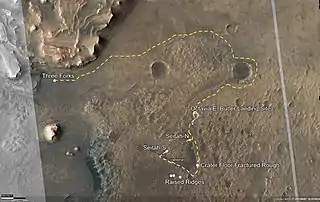

A key mission requirement for this rover is that it must help prepare NASA for its Mars sample-return mission (MSR) campaign,[35][36][37] which is needed before any crewed mission takes place.[13][14][15] Such effort would require three additional vehicles: an orbiter, a fetch rover, and a two-stage, solid-fueled Mars ascent vehicle (MAV).[38][39] Between 20 and 30 drilled samples will be collected and cached inside small tubes by the Perseverance rover,[40] and will be left on the surface of Mars for possible later retrieval by NASA in collaboration with ESA.[37][40] A "fetch rover" would retrieve the sample caches and deliver them to a two-stage, solid-fueled Mars ascent vehicle (MAV). In July 2018, NASA contracted Airbus to produce a "fetch rover" concept study.[41] The MAV would launch from Mars and enter a 500 km orbit and rendezvous with the Next Mars Orbiter or Earth Return Orbiter.[37] The sample container would be transferred to an Earth entry vehicle (EEV) which would bring it to Earth, enter the atmosphere under a parachute and hard-land for retrieval and analyses in specially designed safe laboratories.[36][37]
In the first science campaign Perseverance performs an arching drive southward from its landing site to the Séítah unit to perform a "toe dip" into the unit to collect remote-sensing measurements of geologic targets. After that she will return to the Crater Floor Fractured Rough to collect the first core sample there. Passing by the Octavia B. Butler landing site concludes the first science campaign.
The second campaign shall start with several months of travel towards the "Three Forks" where Perseverance can access geologic locations at the base of the ancient delta of Neretva river, as well as ascend the delta by driving up a valley wall to the northwest.[42]
Spacecraft
Cruise stage and EDLS

- Mars 2020
- Sun
- Earth
- Mars
The three major components of the Mars 2020 spacecraft are the 539 kg (1,188 lb)[43] cruise stage for travel between Earth and Mars; the Entry, Descent, and Landing System (EDLS) that includes the 575 kg (1,268 lb)[43] aeroshell descent vehicle + 440 kg (970 lb) heat shield; and the 1,070 kg (2,360 lb) (fueled mass)[43] descent stage needed to deliver Perseverance and Ingenuity safely to the Martian surface. The Descent Stage carries 400 kg (880 lb) landing propellant for the final soft landing burn after being slowed down by a 21.5 m (71 ft)-wide, 81 kg (179 lb) parachute.[43] The 1,025 kg (2,260 lb)[43] rover is based on the design of Curiosity.[18] While there are differences in scientific instruments and the engineering required to support them, the entire landing system (including the descent stage and heat shield) and rover chassis could essentially be recreated without any additional engineering or research. This reduces overall technical risk for the mission, while saving funds and time on development.[44]
One of the upgrades is a guidance and control technique called "Terrain Relative Navigation" (TRN) to fine-tune steering in the final moments of landing.[45][46] This system allowed for a landing accuracy within 40 m (130 ft) and avoided obstacles.[47] This is a marked improvement from the Mars Science Laboratory mission that had an elliptical area of 7 by 20 km (4.3 by 12.4 mi).[48] In October 2016, NASA reported using the Xombie rocket to test the Lander Vision System (LVS), as part of the Autonomous Descent and Ascent Powered-flight Testbed (ADAPT) experimental technologies, for the Mars 2020 mission landing, meant to increase the landing accuracy and avoid obstacle hazards.[49][50]
Perseverance rover
Perseverance was designed with help from Curiosity's engineering team, as both are quite similar and share common hardware.[18][51] Engineers redesigned Perseverance's wheels to be more robust than Curiosity's, which, after kilometres of driving on the Martian surface, have shown progressed deterioration.[52] Perseverance will have thicker, more durable aluminium wheels, with reduced width and a greater diameter, 52.5 cm (20.7 in), than Curiosity's 50 cm (20 in) wheels.[53][54] The aluminium wheels are covered with cleats for traction and curved titanium spokes for springy support.[55] The combination of the larger instrument suite, new Sampling and Caching System, and modified wheels makes Perseverance 14 percent heavier than Curiosity, at 1,025 kg (2,260 lb) and 899 kg (1,982 lb), respectively.[54] The rover will include a five-jointed robotic arm measuring 2.1 m (6 ft 11 in) long. The arm will be used in combination with a turret to analyze geologic samples from the Martian surface.[56]
A Multi-Mission Radioisotope Thermoelectric Generator (MMRTG), left over as a backup part for Curiosity during its construction, was integrated onto the rover to supply electrical power.[18][57] The generator has a mass of 45 kg (99 lb) and contains 4.8 kg (11 lb) of plutonium dioxide as the source of steady supply of heat that is converted to electricity.[58] The electrical power generated is approximately 110 watts at launch with little decrease over the mission time.[58]
Two lithium-ion rechargeable batteries are included to meet peak demands of rover activities when the demand temporarily exceeds the MMRTG's steady electrical output levels. The MMRTG offers a 14-year operational lifetime, and it was provided to NASA by the United States Department of Energy.[58] Unlike solar panels, the MMRTG does not rely on the presence of the Sun for power, providing engineers with significant flexibility in operating the rover's instruments even at night and during dust storms, and through the winter season.[58]
The Norwegian-developed radar RIMFAX is one of the seven instruments that have been placed on board. The radar has been developed together with FFI (Norwegian Defence Research Establishment), led by Principal Investigator Svein-Erik Hamran of FFI, the Norwegian Space Center,[59] and a number of Norwegian companies. Space has also been found for the first time for an uncrewed helicopter, which will be controlled by NTNU (Norwegian University of Science and Technology) trained cybernetics engineer Håvard Fjær Grip and his team at NASA's Jet Propulsion Laboratory in Los Angeles.[60]
Each Mars mission contributes to an ongoing innovation chain. Each draws on prior operations or tested technologies and contributes uniquely to upcoming missions. By using this strategy, NASA is able to advance the frontiers of what is currently feasible while still depending on earlier advancements.
The Curiosity rover, which touched down on Mars in 2012, is directly responsible for a large portion of Perseverance's rover design, including its entry, descent, and landing mechanism. With perseverance, new technological innovations will be demonstrated, and entry, descent, and landing capabilities will be improved. These advancements will help open the door for future robotic and human missions to the Moon and Mars.
Technology Displays on the Perseverance
Demonstrations of technology are risky experiments that put cutting-edge equipment to the test. Promising technology can be tested on a smaller scale.

Ingenuity helicopter
Ingenuity is a robotic coaxial helicopter that demonstrated the technology for rotorcraft flight in the extremely thin atmosphere of Mars.[61] The aircraft was deployed from the rover's deck, and has flown five times during its 30-day test campaign early in the mission.[62] Each flight took no more than 117 seconds, at altitudes ranging from 3 to 10 m (9.8 to 32.8 ft) off the ground, and a maximum distance of 266 m (873 ft).[61] It used autonomous control and communicated with Perseverance directly after each landing. It is the first powered flight on another planet, and NASA will be able to build on the design for future Mars missions.[63]
Mission

The mission will explore Jezero crater, which scientists speculate was a 250 m (820 ft) deep lake about 3.9 billion to 3.5 billion years ago.[64] Jezero today features a prominent river delta where water flowing through it deposited much sediment over the eons, which is "extremely good at preserving biosignatures".[64][65] The sediments in the delta likely include carbonates and hydrated silica, known to preserve microscopic fossils on Earth for billions of years.[66] Prior to the selection of Jezero, eight proposed landing sites for the mission were under consideration by September 2015; Columbia Hills in Gusev crater, Eberswalde crater, Holden crater, Jezero crater,[67][68] Mawrth Vallis, Northeastern Syrtis Major Planum, Nili Fossae, and Southwestern Melas Chasma.[69]
A workshop was held on 8–10 February 2017 in Pasadena, California, to discuss these sites, with the goal of narrowing down the list to three sites for further consideration.[70] The three sites chosen were Jezero crater, Northeastern Syrtis Major Planum, and Columbia Hills.[71] Jezero crater was ultimately selected as the landing site in November 2018.[64] The "fetch rover" for returning the samples is expected to launch in 2026. The landing and surface operations of the "fetch rover" would take place early in 2029. The earliest return to Earth is envisaged for 2031.[72]
Launch and cruise
.jpg.webp)
The launch window, when the positions of Earth and Mars were optimal for traveling to Mars, opened on 17 July 2020 and lasted through 15 August 2020.[73] The rocket was launched on 30 July 2020 at 11:50 UTC, and the rover landed on Mars on 18 February 2021 at 20:55 UTC, with a planned surface mission of at least one Mars year (668 sols or 687 Earth days).[74][75][76] NASA was not the only Mars mission to use this window: the United Arab Emirates Space Agency launched its Emirates Mars Mission with the Hope orbiter on 20 July 2020, which arrived in Mars orbit on 8 February 2021, and China National Space Administration launched Tianwen-1 on 23 July 2020, arriving in orbit on 10 February 2021 and successfully soft landed with the Zhurong rover on 14 May 2021.[77]
NASA announced that all of the trajectory correction maneuvers (TCM) were a success. The spacecraft fired thrusters to adjust its course toward Mars, shifting the probe's initial post-launch aim point onto the Red Planet.[78]
Entry, descent, and landing (EDL)

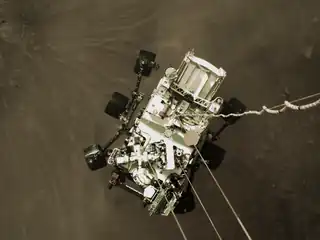
Prior to landing, the Science Team from an earlier NASA lander, InSight, announced that they would attempt to detect the entry, descent and landing (EDL) sequence of the Mars 2020 mission using InSight's seismometers. Despite being more than 3,400 km (2,100 mi) away from the Mars landing site, the team indicated that there was a possibility that InSight's instruments would be sensitive enough to detect the hypersonic impact of Mars 2020's cruise mass balance devices with the Martian surface.[79][80]
The rover's landing was planned similar to the Mars Science Laboratory used to deploy Curiosity on Mars in 2012. The craft from Earth was a carbon fiber capsule that protected the rover and other equipment from heat during entry into the Mars atmosphere and initial guidance towards the planned landing site. Once through, the craft jettisoned the lower heat shield and deployed a parachute from the backshell to slow the descent to a controlled speed. With the craft moving under 320 km/h (200 mph) and about 1.9 km (1.2 mi) from the surface, the rover and sky crane assembly detached from the backshell, and rockets on the sky crane controlled the remaining descent to the planet. As the sky crane moved closer to the surface, it lowered Perseverance via cables until it confirmed touchdown, detached the cables, and flew a distance away to avoid damaging the rover.[81]
Perseverance successfully landed on the surface of Mars with help of the sky crane on 18 February 2021 at 20:55 UTC, to begin its science phase, and began sending images back to Earth.[82] Ingenuity reported back to NASA via the communications systems on Perseverance the following day, confirming its status. The helicopter was not expected to be deployed for at least 60 days into the mission.[83] NASA also confirmed that the on-board microphone on Perseverance had survived entry, descent and landing (EDL), along with other high-end visual recording devices, and released the first audio recorded on the surface of Mars shortly after landing,[84] capturing the sound of a Martian breeze[85] as well as a hum from the rover itself. On 7 May 2021, NASA confirmed that Perseverance managed to record both audio and video from Ingenuity's fourth flight which took place on 30 April 2021.[86]
Major mission milestones and works
_Jezero_Crater_Floor_Fractured_Rough.png.webp)
- 18 February 2021 – Landing of Perseverance on Mars surface
- 4 March 2021 – First major test of Perseverance drive functions
- 3 April 2021 – Deployment of Ingenuity
- 3–4 April 2021 – Mars Environmental Dynamics Analyzer (MEDA) recorded the first weather report on Mars[88]
- 19 April 2021 – First major flight test of Ingenuity
- 20 April 2021 – Mars Oxygen ISRU Experiment (MOXIE) generated 5.37 g (0.189 oz) of oxygen gas from carbon dioxide on its first test on Mars
- 1 June 2021 – Perseverance begins its first science campaign.
- 8 June 2021 – Seventh flight of Ingenuity.
- 21 June 2021 – Eighth flight of Ingenuity. The "watchdog issue", a recurring issue which occasionally prevented Ingenuity from taking flight, is fixed.
- 5 July 2021 – Ninth flight of Ingenuity. This flight is the first to explore areas only an aerial vehicle can, by taking a shortcut over the Séítah unit. The sandy ripples of the Séítah unit would prove too difficult for Perseverance to travel through directly.
- Mid-August 2021 – Perseverance will have acquired its first sample from the ancient lakebed by drilling out "finger-size cores of Martian rock for return to Earth".[89]
- 3 May 2022 – After 27 flights of Ingenuity, the rover lost contact with the helicopter. By holding all scientific operations on the rover to search for and communicate to the helicopter, NASA was able to regain contact with the helicopter to recharge its batteries and return to the rover.
Gallery
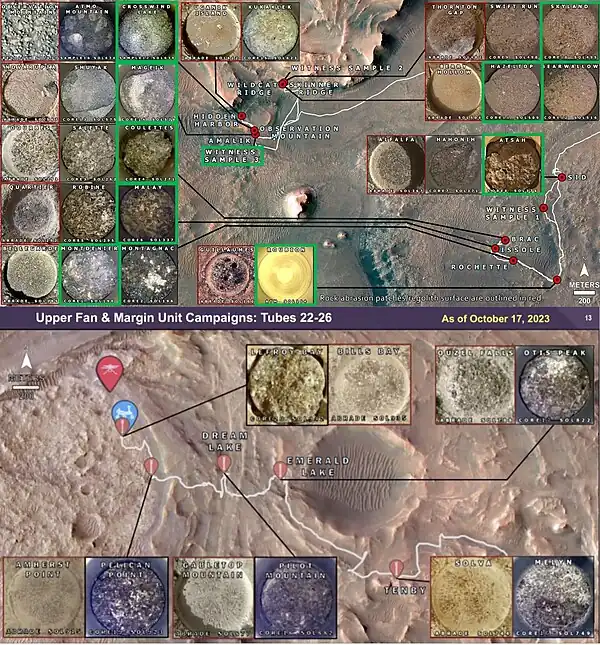
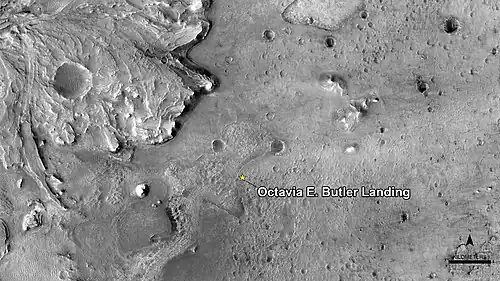



.png.webp)
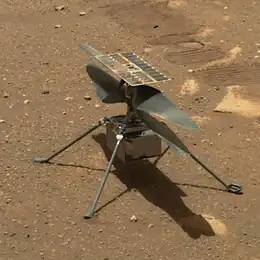


(video; 02:44; 30 April 2021)


Cost
NASA plans to expend roughly US$2.8 billion on the Mars 2020 mission over 10 years: almost US$2.2 billion on the development of the Perseverance rover, US$80 million on the Ingenuity helicopter, US$243 million for launch services, and US$296 million for 2.5 years of mission operations.[35][95] Adjusted for inflation, Mars 2020 is the sixth-most expensive robotic planetary mission made by NASA and is cheaper than its predecessor, the Curiosity rover.[96] As well as using spare hardware, Perseverance also used designs from Curiosity's mission without needing to redesign them, which helped save "probably tens of millions, if not 100 million dollars" according to Mars 2020 Deputy Chief Engineer Keith Comeaux.[97]
Public outreach
To raise public awareness of the Mars 2020 mission, NASA undertook a "Send Your Name To Mars" campaign, through which people could send their names to Mars on a microchip stored aboard Perseverance. After registering their names, participants received a digital ticket with details of the mission's launch and destination. There were 10,932,295 names submitted during the registration period.[98] In addition, NASA announced in June 2019 that a student naming contest for the rover would be held in the fall of 2019, with voting on nine finalist names held in January 2020.[99] Perseverance was announced to be the winning name on 5 March 2020.[100][101]
 "Send Your Name" placard attached to Perseverance
"Send Your Name" placard attached to Perseverance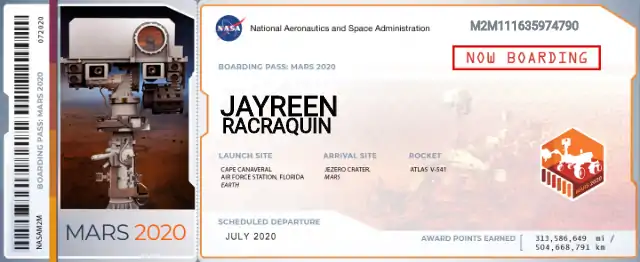 Sample souvenir boarding pass for those who registered their names to be flown aboard the Perseverance rover
Sample souvenir boarding pass for those who registered their names to be flown aboard the Perseverance rover
In May 2020, NASA attached a small aluminum plate to Perseverance to commemorate the impact of the COVID-19 pandemic and pay "tribute to the perseverance of healthcare workers around the world". The COVID-19 Perseverance Plate features planet Earth above the Rod of Asclepius, with a line showing the trajectory of the Mars 2020 spacecraft departing Earth.[102]
A small piece of the wing covering from the Wright brothers' 1903 Wright Flyer is attached to a cable underneath Ingenuity's solar panel.[103]
NASA scientist Swati Mohan delivered the news of the successful landing.[104]
See also
- ExoMars, European-Russian Mars exploration program
- Exploration of Mars
- List of missions to Mars
- Mars Astrobiology Explorer-Cacher
References
- "Where is Perseverance?". Mars 2020 Mission Perseverance Rover. NASA. Retrieved 20 August 2022.
- "NASA's Mars Helicopter Survives First Cold Martian Night on Its Own". Nasa Mars Website.
 This article incorporates text from this source, which is in the public domain.
This article incorporates text from this source, which is in the public domain. - "NASA to Attempt First Controlled Flight on Mars As Soon As Monday". 17 April 2021.
 This article incorporates text from this source, which is in the public domain.
This article incorporates text from this source, which is in the public domain. - "NASA, ULA Launch Mars 2020 Perseverance Rover Mission to Red Planet". NASA. 30 July 2020. Retrieved 2 August 2020.
 This article incorporates text from this source, which is in the public domain.
This article incorporates text from this source, which is in the public domain. - "Touchdown! NASA's Mars Perseverance Rover Safely Lands on Red Planet". NASA's Mars Exploration Program. 18 February 2021. Retrieved 19 February 2021.
 This article incorporates text from this source, which is in the public domain.
This article incorporates text from this source, which is in the public domain. - "Welcome to 'Octavia E. Butler Landing'". NASA. 5 March 2021. Retrieved 5 March 2021.
 This article incorporates text from this source, which is in the public domain.
This article incorporates text from this source, which is in the public domain. - Strickland, Ashley (15 April 2021). "Why Mars? The fascination with exploring the red planet". CNN. Retrieved 19 March 2023.
- "Mars | Facts, Surface, Moons, Temperature, & Atmosphere | Britannica". www.britannica.com. Retrieved 19 March 2023.
- Ben Turner (16 July 2021). "Some evidence of ancient Martian life has mysteriously vanished, NASA finds". livescience.com. Retrieved 19 March 2023.
- mars.nasa.gov. "Mars Technologies - NASA". mars.nasa.gov. Retrieved 19 March 2023.
- Chang, Kenneth (15 September 2022). "Life on Mars? This Could Be the Place NASA's Rover Helps Us Find It". The New York Times. ISSN 0362-4331. Retrieved 19 March 2023.
- Chang, Alicia (9 July 2013). "Panel: Next Mars rover should gather rocks, soil". Associated Press. Retrieved 12 July 2013.
- Schulte, Mitch (20 December 2012). "Call for Letters of Application for Membership on the Science Definition Team for the 2020 Mars Science Rover" (PDF). NASA. NNH13ZDA003L.
 This article incorporates text from this source, which is in the public domain.
This article incorporates text from this source, which is in the public domain. - "Summary of the Final Report" (PDF). NASA / Mars Program Planning Group. 25 September 2012.
 This article incorporates text from this source, which is in the public domain.
This article incorporates text from this source, which is in the public domain. - Moskowitz, Clara (5 February 2013). "Scientists Offer Wary Support for NASA's New Mars Rover". Space.com. Retrieved 5 February 2013.
- Amos, Jonathan (4 December 2012). "NASA to send new rover to Mars in 2020". BBC News. Retrieved 5 December 2012.
- February 2021, Mike Wall 17 (17 February 2021). "The sounds of Mars: NASA's Perseverance rover will put ears on the Red Planet for the 1st time". Space.com. Retrieved 18 February 2021.
- Harwood, William (4 December 2012). "NASA announces plans for new US$1.5 billion Mars rover". CNET. Retrieved 5 December 2012.
Using spare parts and mission plans developed for NASA's Curiosity Mars rover, the space agency says it can build and launch the rover in 2020 and stay within current budget guidelines.
- Matson, John (21 February 2013). "Has NASA Become Mars-Obsessed?". Scientific American. Retrieved 8 December 2013.
- Reilly, Doug (6 December 2012). "NASA Announces New Mars Rover: De ja vu, all over again…". bicycleastronomy.org. Retrieved 8 December 2013.
- Rosie Mestel (6 December 2012). "Bill Nye, the (planetary) science guy, on NASA's future". Los Angeles Times. Retrieved 3 July 2013.
- "Program And Missions – 2020 Mission Plans". NASA. 2015.
 This article incorporates text from this source, which is in the public domain.
This article incorporates text from this source, which is in the public domain. - Mann, Adam (4 December 2012). "NASA Announces New Twin Rover for Curiosity Launching to Mars in 2020". Wired. Retrieved 5 December 2012.
- Leone, Dan (3 October 2012). "Mars Planning Group Endorses Sample Return". SpaceNews.
- Greicius, Tony (2 March 2015). "Science Team Outlines Goals for NASA's 2020 Mars Rover". NASA. Retrieved 19 February 2021.
 This article incorporates text from this source, which is in the public domain.
This article incorporates text from this source, which is in the public domain. - Davis, Jason (28 August 2017). "NASA considers kicking Mars sample return into high gear". The Planetary Society.
- "Announcement of Opportunity: Mars 2020 Investigations" (PDF). NASA. 24 September 2013. Retrieved 18 May 2014.
 This article incorporates text from this source, which is in the public domain.
This article incorporates text from this source, which is in the public domain. - "Mars 2020 Mission: Instruments". NASA. 2013. Retrieved 18 May 2014.
 This article incorporates text from this source, which is in the public domain.
This article incorporates text from this source, which is in the public domain. - Brown, Dwayne (31 July 2014). "Release 14-208 – NASA Announces Mars 2020 Rover Payload to Explore the Red Planet as Never Before". NASA. Retrieved 31 July 2014.
 This article incorporates text from this source, which is in the public domain.
This article incorporates text from this source, which is in the public domain. - "Objectives – 2020 Mission Plans". mars.nasa.gov. Retrieved 4 December 2015.
 This article incorporates text from this source, which is in the public domain.
This article incorporates text from this source, which is in the public domain. - "Science Team Outlines Goals for NASA's 2020 Mars Rover". Jet Propulsion Laboratory. NASA. 9 July 2013. Retrieved 10 July 2013.
 This article incorporates text from this source, which is in the public domain.
This article incorporates text from this source, which is in the public domain. - Klotz, Irene (21 November 2013). "Mars 2020 Rover To Include Test Device To Tap Planet's Atmosphere for Oxygen". SpaceNews. Retrieved 29 December 2019.
- Bergin, Chris (2 September 2014). "Curiosity EDL data to provide 2020 Mars Rover with super landing skills". NASASpaceFlight.com.
- "Mars 2020 Rover – Overview". NASA/JPL. Retrieved 6 July 2018.
 This article incorporates text from this source, which is in the public domain.
This article incorporates text from this source, which is in the public domain. - "Mars 2020 Landing Press Kit" (PDF). JPL. NASA. p. 15. Retrieved 17 February 2021.
 This article incorporates text from this source, which is in the public domain.
This article incorporates text from this source, which is in the public domain. - Evans, Kim (13 October 2015). "NASA Eyes Sample-Return Capability for Post-2020 Mars Orbiter". Denver Museum of Nature and Science. Retrieved 10 November 2015.
- Mattingly, Richard (March 2010). "Mission Concept Study: Planetary Science Decadal Survey – MSR Orbiter Mission (Including Mars Returned Sample Handling)" (PDF). NASA.
 This article incorporates text from this source, which is in the public domain.
This article incorporates text from this source, which is in the public domain. - Ross, D.; Russell, J.; Sutter, B. (March 2012). "Mars Ascent Vehicle (MAV): Designing for high heritage and low risk". 2012 IEEE Aerospace Conference. pp. 1–6. doi:10.1109/AERO.2012.6187296. ISBN 978-1-4577-0557-1. S2CID 21266048.
- Prince, Andrew; McCauley, Rachel; Kibbey, Timothy; McCollum, Lisa; Oglesby, Britt; Stenfanski, Philip (March 2019). "Mars Ascent Vehicle (MAV)" (PDF).
 This article incorporates text from this source, which is in the public domain.
This article incorporates text from this source, which is in the public domain. - How NASA's Next Mars Rover Will Hunt for Alien Life. Mike Wall, Space.com, 11 December 2019
- Amos, Jonathan (6 July 2018). "Fetch rover! Robot to retrieve Mars rocks". BBC News. Retrieved 9 July 2018.
- Perseverance's First Road Trip
- "Fiche Technique: Mars 2020 Vaisseau Spatial" [Mars 2020]. Espace & Exploration (in French). No. 61. January 2021. pp. 42–43. Archived from the original on 16 January 2021. Retrieved 5 February 2021.
- Dreier, Casey (10 January 2013). "New Details on the 2020 Mars Rover". The Planetary Society. Retrieved 15 March 2013.
- Agle, D. C. (1 July 2019). "A Neil Armstrong for Mars: Landing the Mars 2020 Rover". NASA. Retrieved 1 July 2019.
 This article incorporates text from this source, which is in the public domain.
This article incorporates text from this source, which is in the public domain. - "Mars 2020 Rover: Entry, Descent, and Landing System". NASA. July 2016. Retrieved 17 July 2016.
 This article incorporates text from this source, which is in the public domain.
This article incorporates text from this source, which is in the public domain. - Here's an example of the crazy lengths NASA goes to land safely on Mars. Eric Berger, Ars Technica, 7 October 2019
- "NASA Mars Rover Team Aims for Landing Closer to Prime Science Site". 11 June 2012. Retrieved 28 January 2021.
- Williams, Leslie; Webster, Guy; Anderson, Gina (4 October 2016). "NASA Flight Program Tests Mars Lander Vision System". NASA. Retrieved 5 October 2016.
 This article incorporates text from this source, which is in the public domain.
This article incorporates text from this source, which is in the public domain. - Murphy, Marshall (4 October 2016). "Fresh Eyes on Mars: Mars 2020 Lander Vision System Tested through NASA's Flight Opportunities Program". NASA. Retrieved 28 January 2021.
 This article incorporates text from this source, which is in the public domain.
This article incorporates text from this source, which is in the public domain. - Wall, Mike (4 December 2012). "NASA to Launch New Mars Rover in 2020". Space.com. Retrieved 5 December 2012.
- Lakdawalla, Emily (19 August 2014). "Curiosity wheel damage: The problem and solutions". planetary.org/blogs. The Planetary Society. Retrieved 22 August 2014.
- Gebhardt, Chris (11 October 2016). "Mars 2020 rover receives upgraded eyesight for tricky skycrane landing". NASASpaceFlight. Retrieved 11 October 2016.
- "Mars 2020 – Body: New Wheels for Mars 2020". NASA/JPL. Retrieved 6 July 2018.
 This article incorporates text from this source, which is in the public domain.
This article incorporates text from this source, which is in the public domain. - "Mars 2020 Rover – Wheels". NASA. Retrieved 9 July 2018.
 This article incorporates text from this source, which is in the public domain.
This article incorporates text from this source, which is in the public domain. - "Mars 2020 Rover's 7-Foot-Long Robotic Arm Installed". mars.nasa.gov. 28 June 2019. Retrieved 1 July 2019.
The main arm includes five electrical motors and five joints (known as the shoulder azimuth joint, shoulder elevation joint, elbow joint, wrist joint and turret joint). Measuring 7 feet (2.1 meters) long, the arm will allow the rover to work as a human geologist would: by holding and using science tools with its turret, which is essentially its "hand".
 This article incorporates text from this source, which is in the public domain.
This article incorporates text from this source, which is in the public domain. - Boyle, Alan (4 December 2012). "NASA plans 2020 Mars rover remake". Cosmic Log. NBC News. Archived from the original on 27 February 2015. Retrieved 5 December 2012.
- "Mars 2020 Rover Tech Specs". JPL/NASA. Retrieved 6 July 2018.
 This article incorporates text from this source, which is in the public domain.
This article incorporates text from this source, which is in the public domain. - Romsenter, Norsk. "Svein-Erik Hamran". Norsk Romsenter (in Norwegian). Retrieved 4 June 2021.
- Helland Urke, Eirik (18 February 2021). "Direkte: Mars Perseverance har landet!". Teknisk Ukeblad (in Norwegian). Retrieved 20 February 2021.
- "Ingenuity Mars Helicopter Landing Press Kit" (PDF). NASA. January 2021. Retrieved 14 February 2021.
 This article incorporates text from this source, which is in the public domain.
This article incorporates text from this source, which is in the public domain. - Decision expected soon on adding helicopter to Mars 2020 Jeff Fout, SpaceNews, 4 May 2018
- Mars Helicopter Technology Demonstrator, J. (Bob) Balaram, Timothy Canham, Courtney Duncan, Matt Golombek, Håvard Fjær Grip, Wayne Johnson, Justin Maki, Amelia Quon, Ryan Stern, and David Zhu. American Institute of Aeronautics and Astronautics (AIAA), SciTech Forum Conference; 8–12 January 2018, Kissimmee, Florida doi:10.2514/6.2018-0023
 This article incorporates text from this source, which is in the public domain.
This article incorporates text from this source, which is in the public domain. - Chang, Kenneth (19 November 2018). "NASA Mars 2020 Rover Gets a Landing Site: A Crater That Contained a Lake – The rover will search the Jezero Crater and delta for the chemical building blocks of life and other signs of past microbes". The New York Times. Retrieved 21 November 2018.
- Wall, Mike (19 November 2018). "Jezero Crater or Bust! NASA Picks Landing Site for Mars 2020 Rover". Space.com. Retrieved 20 November 2018.
- The Perseverance rover will visit the perfect spot to find signs of life, new studies show Sarah Kaplan, The Washington Post, 16 November 2019
- Hand, Eric (6 August 2015). "Mars scientists tap ancient river deltas and hot springs as promising targets for 2020 rover". Science News. Retrieved 7 August 2015.
- "PIA19303: A Possible Landing Site for the 2020 Mission: Jezero Crater". NASA. 4 March 2015. Retrieved 7 March 2015.
 This article incorporates text from this source, which is in the public domain.
This article incorporates text from this source, which is in the public domain. - Farley, Ken (8 September 2015). "Researcher discusses where to land Mars 2020". Phys.org. Retrieved 9 September 2015.
- "2020 Landing Site for Mars Rover Mission". NASA / Jet Propulsion Laboratory. Archived from the original on 20 April 2017. Retrieved 12 February 2017.
 This article incorporates text from this source, which is in the public domain.
This article incorporates text from this source, which is in the public domain. - Witze, Alexandra (11 February 2017). "Three sites where NASA might retrieve its first Mars rock". Nature. Bibcode:2017Natur.542..279W. Retrieved 12 February 2017.
- How the Perseverance Mars Rover Will Help NASA Return Mars Samples to Earth. NASA. 28 July 2020. Event occurs from 39:55 to 42:13.
 This article incorporates text from this source, which is in the public domain.
This article incorporates text from this source, which is in the public domain. - Foust, Jeff (30 June 2020). "Mars 2020 launch slips again". SpaceNews. Retrieved 30 July 2020.
- Ray, Justin (25 July 2016). "NASA books nuclear-certified Atlas 5 rocket for Mars 2020 rover launch". Spaceflight Now. Retrieved 26 July 2016.
- mars.nasa.gov. "Overview – Mars 2020 Rover". mars.nasa.gov. Retrieved 19 February 2019.
 This article incorporates text from this source, which is in the public domain.
This article incorporates text from this source, which is in the public domain. - "Mission: Overview". NASA. Retrieved 7 March 2015.
 This article incorporates text from this source, which is in the public domain.
This article incorporates text from this source, which is in the public domain. - Bachman, Justin (8 February 2021). "Three Mars Missions Set to Arrive This Month". Bloomberg News. Retrieved 22 February 2021.
- "Mars missions complete first course corrections on journey to Red Planet". Spaceflight Now. 19 August 2020. Retrieved 20 August 2020.
- Fernando, Benjamin; Wójcicka, Natalia; Froment, Marouchka; Maguire, Ross; Stähler, Simon C.; Rolland, Lucie; Collins, Gareth S.; Karatekin, Ozgur; Larmat, Carene; Sansom, Eleanor K.; Teanby, Nicholas A. (2021). "Listening for the Landing: Seismic Detections of Perseverance's arrival at Mars with InSight". Earth and Space Science. 8 (4): e2020EA001585. Bibcode:2021E&SS....801585F. doi:10.1029/2020EA001585. ISSN 2333-5084.
- O'Callaghan, Jonathan. "NASA probe on Mars may feel the ground shake as rovers land in 2021". New Scientist. Retrieved 11 February 2021.
- Betz, Eric (18 February 2021). "The Skycrane: How NASA's Perseverance rover will land on Mars". Astronomy.com. Retrieved 22 February 2021.
- Strickland, Ashley (19 February 2021). "Incredible new images shared by Perseverance rover after Mars landing". CNN. Retrieved 20 February 2021.
- Strickland, Ashley (20 February 2021). "Ingenuity helicopter phones home from Mars". CNN. Retrieved 22 February 2021.
- Strickland, Ashley (23 February 2021). "NASA shares first video and audio, new images from Mars Perseverance rover". CNN. Retrieved 23 February 2021.
- Crane, Leah (22 February 2021). "Perseverance rover has sent back stunning video and audio from Mars". New Scientist. Retrieved 24 February 2021.
- "NASA's Perseverance Captures Video, Audio of Fourth Ingenuity Flight". NASA. 7 May 2021. Retrieved 7 May 2021.
 This article incorporates text from this source, which is in the public domain.
This article incorporates text from this source, which is in the public domain. - "Perseverance Scouts First Sampling Location". NASA. 7 July 2021.
 This article incorporates text from this source, which is in the public domain.
This article incorporates text from this source, which is in the public domain. - Cappucci, Matthew (8 April 2021). "NASA receives first weather reports from Perseverance rover on Mars at Jezero Crater – The weather data is crucial as the first flight of Ingenuity draws near". The Washington Post. Retrieved 8 April 2021.
- Voosem, Paul (21 June 2021). "NASA's Perseverance rover to drill first samples of martian rock". Science. AAAS. Retrieved 1 August 2021.
- "Nobody Tell Elmo About Issole". nasa.gov. Retrieved 11 February 2022.
- mars.nasa.gov. "NASA's Perseverance Plans Next Sample Attempt". NASA’s Mars Exploration Program. Retrieved 27 August 2021.
- "Sample Caching Dry Run, 1st sample tube cached". Twitter. Retrieved 27 August 2021.
- mars.nasa.gov. "Perseverance Sample Tube 266". NASA’s Mars Exploration Program. Retrieved 9 September 2021.
- Chang, Kenneth (27 April 2022). "NASA Sees 'Otherworldly' Wreckage on Mars With Ingenuity Helicopter - The debris was part of the equipment that helped the Perseverance mission safely land on the red planet in 2021". The New York Times. Retrieved 28 April 2022.
- "Cost of Perseverance". The Planetary Society.
- Dreier, Casey (29 July 2020). "The Cost of Perseverance, in Context". The Planetary Society.
- "Answering Your (Mars 2020) Questions: Perseverance versus Curiosity Rover Hardware". techbriefs.com. 19 June 2020. Retrieved 17 February 2021.
- "Send Your Name to Mars: Mars 2020". mars.nasa.gov. Retrieved 12 February 2020.
 This article incorporates text from this source, which is in the public domain.
This article incorporates text from this source, which is in the public domain. - Agle, D.C.; Hautaluoma, Grwy; Johnson, Alana (21 January 2020). "Nine Finalists Chosen in NASA's Mars 2020 Rover Naming Contest". NASA. Retrieved 21 January 2020.
 This article incorporates text from this source, which is in the public domain.
This article incorporates text from this source, which is in the public domain. - Hautaluoma, Grey; Johnsom, Alana; Agle, DC (5 March 2020). "Virginia Middle School Student Earns Honor of Naming NASA's Next Mars Rover "Perseverance"". NASA. Retrieved 5 March 2020.
 This article incorporates text from this source, which is in the public domain.
This article incorporates text from this source, which is in the public domain. - Chang, Kenneth (5 March 2020). "NASA's Mars 2020 Rover Gets New, Official Name: Perseverance – The robotic explorer is to join Curiosity on the red planet next year, and is expected to get more rolling companions built by China, Europe and Russia". The New York Times. Retrieved 6 March 2020.
- "The Launch Is Approaching for NASA's Next Mars Rover, Perseverance". NASA. 17 June 2020. Archived from the original on 17 June 2020.
 This article incorporates text from this source, which is in the public domain.
This article incorporates text from this source, which is in the public domain. - Potter, Sean (23 May 2021). "NASA Ingenuity Mars Helicopter Prepares for First Flight". NASA.
 This article incorporates text from this source, which is in the public domain.
This article incorporates text from this source, which is in the public domain. - Kaur, Harmeet (19 February 2021). "The face of the Perseverance landing was an Indian American woman". CNN. Retrieved 20 February 2021.
External links
- Official website
- Mars 2020: Assembly – Overall description (NASA)
- Mars 2020: Science Definition Team Report (NASA)
- Mars 2020: Send Your Name To Mars
- Mars 2020: Vote for the Name of the Rover
- Mars 2020: NASA Eyes-on-the-Solar-System
- Video
- Mars 2020: Proposed Science Goals (3:09; July 2013) on YouTube
- Mars 2020: Rover and Beyond Conference (51:42; July 2014) on YouTube
- Mars 2020: Next Mission to Mars (8:57; May 2017) on YouTube
- Mars 2020: Building the Mission (3:00; December 2017) on YouTube
- Mars 2020: Building the Rover (3:50; October 2018) on YouTube
- Mars 2020: Jezero crater flyover (2:13; December 2018) on YouTube
- Mars 2020: Assembly – (Live stream; since November 2019) on YouTube
- Mars 2020: Overview (2:58; July 2020) on YouTube
- Mars 2020: LAUNCH of Rover (6:40; 30 July 2020) on YouTube
- Mars 2020: LAUNCH of Rover (1:11; 30 July 2020; NASA) on YouTube
- Mars 2020: LANDING of Rover (3:25; 18 February 2021; NASA) on YouTube
- Mars 2020: LANDING of Rover (3:55pm/et/usa, 18 February 2021
- Video: Mars Perseverance rover/Ingenuity helicopter report (9 May 2021; CBS-TV, 60 Minutes; 13:33)



.jpg.webp)
.jpg.webp)

.png.webp)









.jpg.webp)


.jpg.webp)
.jpg.webp)


_on_Jul_14_2020_aligned_to_stars.jpg.webp)


